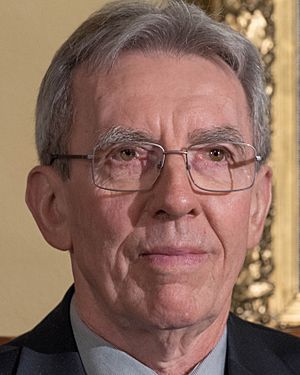Jean-Pierre Sauvage facts for kids
Quick facts for kids
Jean-Pierre Sauvage
|
|
|---|---|

Sauvage at Nobel press conference in Stockholm, Sweden, December 2016
|
|
| Born | 21 October 1944 Paris, France
|
| Nationality | French |
| Education | ECPM Strasbourg |
| Awards |
|
| Scientific career | |
| Fields | coordination chemistry, supramolecular chemistry |
| Institutions | Strasbourg University |
| Thesis | Les Diaza-polyoxa-macrobicycles et leur cryptates (1971) |
| Doctoral advisor | Jean-Marie Lehn |
Jean-Pierre Sauvage, born on October 21, 1944, is a French scientist. He is a chemist who studies how atoms and molecules connect. He works at Strasbourg University. He is famous for his work in supramolecular chemistry. This field looks at how molecules can be put together like tiny building blocks. In 2016, he won the Nobel Prize in Chemistry. He shared this award with Sir J. Fraser Stoddart and Bernard L. Feringa. They were honored for creating tiny machines out of molecules.
Contents
About Jean-Pierre Sauvage
Sauvage was born in Paris, France, in 1944. He studied chemistry at the National School of Chemistry of Strasbourg. He earned his PhD degree from the Université Louis-Pasteur. His teacher was Jean-Marie Lehn, who also won a Nobel Prize in Chemistry in 1987. Sauvage helped create special molecules called cryptand ligands during his studies. After working in England for a short time, he returned to Strasbourg. He is now a professor there.
Building Tiny Molecular Machines
Sauvage's main work is about making molecules that act like machines. These tiny machines can change their shape or move when given a signal. Think of them as incredibly small robots.
His most important discovery happened in 1983. He was the first to create a catenane. A catenane is made of two ring-shaped molecules that are linked together. They are linked like two links in a chain. These rings are not connected by a chemical bond. Instead, they are held together mechanically. This means they can move freely around each other.
This discovery was a huge step towards making molecular machines. The Nobel Prize committee recognized this important work. The other two scientists who shared the prize built on Sauvage's ideas. They later created other molecular machines. These included a rotaxane and a molecular rotor.
Other Scientific Discoveries
Sauvage has also done other interesting research. He studied how to turn carbon dioxide into useful things. This process is called electrochemical reduction of CO2. He also worked on models of photosynthesis. Photosynthesis is how plants use sunlight to make energy.
A big part of his work involves molecular topology. This is about how molecules are shaped and linked. He has created not only catenanes but also molecular knots. These are molecules tied into tiny knots. He uses special metal atoms to help form these complex shapes.
Awards and Recognition
Jean-Pierre Sauvage has received many honors for his work. He became a member of the French Academy of Sciences in 1997. In April 2019, he was also chosen as a foreign associate of the US National Academy of Sciences. His most famous award is the 2016 Nobel Prize in Chemistry. He earned it for his groundbreaking work on molecular machines.
See also
 In Spanish: Jean-Pierre Sauvage para niños
In Spanish: Jean-Pierre Sauvage para niños



